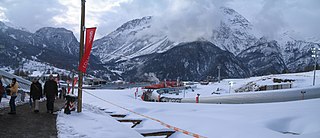
Cesana Pariol was the venue for bobsleigh, luge and skeleton during the 2006 Winter Olympics in Turin, Italy. The track, built for the games, is located in Cesana. The venue holds approximately 7,130 spectators, of whom 3,624 are seated.

The International Luge Federation (French: Fédération Internationale de Luge de Course(FIL); German: Internationaler Rennrodelverband) is the main international federation for all luge sports. Founded by 13 nations at Davos, Switzerland in 1957, it has members of 53 national luge associations as of 2009 and is based in Berchtesgaden, Germany. In reaction to the 2022 Russian invasion of Ukraine, in March 2022 the FIL banned all Russian athletes, coaches, and officials from its events, suspended all Russian officials appointed to its Commissions and Working Groups, and deemed Russia ineligible to host any of its events.

The Oberhof bobsleigh, luge, and skeleton track is a venue used for bobsled, luge and skeleton located in Oberhof, Germany.

The Altenberg bobsleigh, luge, and skeleton track is a venue in Germany for bobsleigh, luge, and skeleton. Located in Saxony in eastern Germany, it is northwest of Altenberg, near the border with the Czech Republic.

The Königssee bobsleigh, luge, and skeleton track is a venue in Germany for bobsleigh, luge and skeleton, located in Schönau am Königssee, Bavaria, near Königssee and the border with Austria. Completed 56 years ago in 1968, it is the first permanent, artificially refrigerated bobsleigh, luge, and skeleton track in the world. In July 2021, the track was severely damaged by the floods that affected the European continent, and is currently under reconstruction.
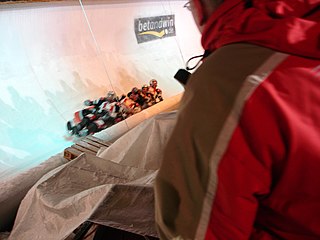
The Olympic Sliding Centre Innsbruck is a venue for bobsleigh, luge and skeleton located in Igls, Austria. The most recent version of the track was completed in 1975 and is the first permanent, combination artificially refrigerated bobsleigh, luge, and skeleton track, serving as a model for other tracks of its kind worldwide. It hosted the bobsleigh, luge, and skeleton competitions for the 2012 Winter Youth Olympics.

The Mt. Van Hoevenberg Olympic Bobsled Run is a venue for bobsleigh, luge and skeleton in the United States, located at the Lake Placid Olympic Sports Complex in Lake Placid, New York. This venue was used for the 1932 and 1980 Winter Olympics and for the only winter Goodwill Games in 2000. The track hosted both the first FIBT World Championships and FIL World Luge Championships held outside of Europe, doing so in 1949 and 1983. The third and most recent version of the track was completed in 2000. In 2010 the bobsled track was listed on the National Register of Historic Places.
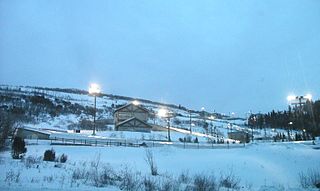
The Utah Olympic Park Track is a bobsleigh, luge, and skeleton track in the United States, located in the Utah Olympic Park near Park City, Utah. During the 2002 Winter Olympics in nearby Salt Lake City, the track hosted the bobsleigh, luge, and skeleton events, and is expected to reprise these roles for the 2034 Winter Olympics. Today the track still serves as a training center for Olympic and development level athletes and hosts numerous local and international competitions. It is one of two national tracks; the other is at Mt. Van Hoevenberg near Lake Placid, New York.

The Sigulda Bobsleigh and Luge Track is located in Sigulda, Latvia, built in 1986. Currently, the track manager is Dainis Dukurs, former bobsleigh brakeman and the father of skeleton racers Martins and Tomass Dukurs.
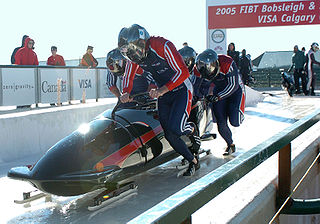
The Canada Olympic Park bobsleigh, luge, and skeleton track is a bobsleigh, luge, and skeleton track located in Calgary, Alberta. Part of Canada Olympic Park, it hosted the bobsleigh and luge competitions at the 1988 Winter Olympics. This track is one of only two of its type in the world to be featured in a non-documentary film when it was part of the 1993 American film Cool Runnings which loosely followed the Jamaican Bobsled Team during their competition in bobsleigh at the 1988 Games.

The Whistler Sliding Centre is a Canadian bobsleigh, luge, and skeleton track located in Whistler, British Columbia, that is 125 km (78 mi) north of Vancouver. The centre is part of the Whistler Blackcomb resort, which comprises two ski mountains separated by Fitzsimmons Creek. Located on the lowermost slope of the northern mountain, Whistler Sliding Centre hosted the bobsleigh, luge, and skeleton competitions for the 2010 Winter Olympics.
The La Plagne bobsleigh, luge, and skeleton track is a bobsleigh, luge, and skeleton track located in La Plagne, France. The track was the venue for the bobsleigh and luge competitions for the 1992 Winter Olympics whose host city was neighboring Albertville.

Lillehammer Olympic Bobsleigh and Luge Track is a bobsleigh, luge and skeleton track located at Hunderfossen in Fåberg, Norway, 15 kilometers (9 mi) north of the town center of Lillehammer. It was completed in 1992 for the 1994 Winter Olympics, where it hosted the bobsleigh events and luge events. It has since also hosted the FIBT World Championships 1995 in skeleton and the FIL World Luge Championships 1995, and hosted 2016 Winter Youth Olympics.
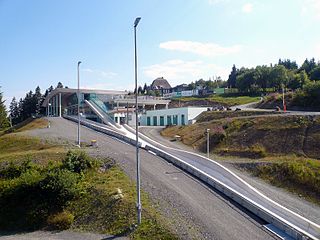
The Winterberg bobsleigh, luge, and skeleton track is a bobsleigh, luge, and skeleton track located in Winterberg, Germany. It is the only track of its kind in the world with a turn that has corporate sponsorship with turn seven being sponsored by Veltins, a German brewery which has its headquarters located in neighboring Meschede.
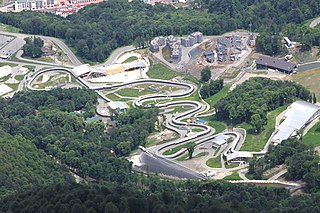
The Sliding Center Sanki (Санки) is a bobsleigh, luge, and skeleton track located in Rzhanaya Polyana, Russia, 60 km (37 mi) northeast of Sochi. Located in the Western Caucasus. The venue hosted the bobsleigh, luge, and skeleton events for the 2014 Winter Olympics.
Renato Hiromi Gimenez Mizoguchi is a Brazilian luger who competed from 2001 to 2005. He is best known for his severe injuries suffered during the homologation process of Cesana Pariol, the bobsleigh, luge, and skeleton track for the 2006 Winter Olympics in Turin, in January 2005. Mizoguchi's injuries led to a donation set up by the International Luge Federation (FIL) in Germany to pay for his expenses and also to track modifications after discussion both by the FIL and the International Bobsleigh and Skeleton Federation during 2005 with approval finally reached in October of that year.

For the 1976 Winter Olympics in Innsbruck, Austria, a total of eight sports venues were used. The games were originally awarded to Denver, Colorado in the United States in 1970, but they withdrew in the wake of Colorado residents voting against it for environmental and cost reasons in November 1972. This led to the International Olympic Committee opening up the bids for the games again, eventually awarding them to Innsbruck in February 1973. The Austrian city, having hosted the Winter Olympics in 1964, was in the process of having the venues used for those Games before Denver's with clear cutting of the alpine skiing venues, lessening of the amount of cross-country skiing routes, upgrading the ski jumps, adding lighting in the indoor sports arena to accommodate color television, and the construction of a combination bobsleigh and luge track. After the 1976 Games, the venues have remained in use, hosting events in Nordic skiing and the sliding sports. They hosted some of the events for the Winter Universiade in 2005 and seven of the eight venues served as host for the first Winter Youth Olympic Games in 2012.

For the 1980 Winter Olympics in Lake Placid, New York, United States, a total of seven sports venues were used. All five of the venues used for the 1932 Winter Olympics were also used at the 1980 Winter Games with adjustments. These adjustments included electronic scoreboards, increased refrigeration, and the addition of a separate luge track. This was the last Winter Olympics where there were separate bobsleigh and luge tracks. The closest finish in Olympic history in cross-country skiing led skiing officials to time future events in hundredths of a second rather than tenths of a second. This would also apply to biathlon events. Eric Heiden won five gold medals at the speed skating oval while the "Miracle on Ice" took place between Americans and Soviets at the Olympic Center. In the late 1990s, the luge track was demolished and a new combination track was constructed in time for the only Winter Goodwill Games held. The sliding venue was named to the American National Register of Historical Places in February 2010.

For the 1998 Winter Olympics in Nagano, Japan, a total of fifteen sports venues were used. Nagano had attempted twice to host the Winter Olympics, losing out to Sapporo, host of the 1972 Winter Olympics. The third time, in 1991, Nagano edged out Salt Lake City to host the 1998 Games. The biathlon venue was adjusted in accordance with the Washington Convention over endangered species. The biggest venue controversy was at Happo'one resort on the length of the men's downhill and the battle that ensued to the point where skiing officials threatened to pull the event entirely before a compromise was reached three months before the Olympics. M-Wave has hosted three World Speed Skating Championships since the Olympics, while the Spiral has hosted a couple of world championships in bobsleigh, luge and skeleton.

Sarajevo Olympic Bobsleigh and Luge Track is a bobsleigh and luge track situated on Trebević mountain overlooking the City of Sarajevo, built for the 1984 Winter Olympics.




















